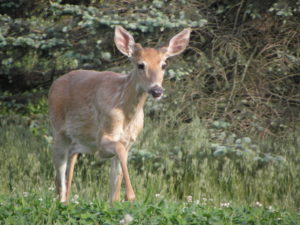By Glen Wunderlich
With summer at the doorstep, the process of growing deer is in full swing. This year’s mix of high-yield treats will be planted to maximize attractiveness and nutritional value throughout the year. To do so, however, takes a fair amount of planning.
Late last summer, a blend of brassicas and legumes was planted in a small plot giving the local herd some fine turnips and rape plants for forage during hunting season and well into the winter months. Not all the plants were consumed, thus allowing the remnants to decompose and to provide nutrients to the developing clover and alfalfa plants that would now take over.
However, in comparison to a nearby healthy food plot of ladino clover, the new perennial plot was a pale green – nothing that a shot of fertilizer wouldn’t cure. And, if one wonders about the difference in a plot that is well-maintained and one that has been neglected, a trailcam won’t lie.
A perennial plot that was “sweetened” in the fall continually drew more deer than even a nearby brassica plot.
On several occasions, another trailcam has also revealed a striking revelation immediately following a thunderstorm with lightning: A tiny plot – maybe a quarter of an acre – has drawn as many as 50 swarming deer, as though the dinner bell rang at the storm’s conclusion.
In a thunderstorm there is enough electrical energy in lightning to separate the nitrogen atoms in the air, thus making them available to plants. Once the atoms are separated they can fall to earth with rain water, and combine with minerals in the soil to form nitrates. This form of fertilizer is obviously readily available and attractive to deer. The point is that fertilizer makes all the difference in desirability.
Another means to improve the attractiveness of clover and alfalfa is to periodically mow. The new growth that follows a haircut makes for a tender and juicy salad!

spring buck in clover plot
This year’s experiment with annuals continues, as a blend of soybeans and sugar beets is on the planting schedule for July 1. The idea is to make luscious soybean foliage available to the deer, when typical soybeans are brown and being harvested. Sugar beets speak for themselves and should be another good energy source in the bitter cold.
Unfortunately, there was no preparation last fall, so herbicide was applied late April to rid the site of grass. The challenge has been to get the old Ford tractor on the site to disk up the dying vegetation, because a wet spring delayed progress. Since then, lime and fertilizer has been disked into the soil, but with about three weeks until planting time, more prep is needed.
So, whether you settle on annuals or perennials or both, understand a lot of time, energy, and some cash are all part of the equation for healthy deer that’ll call your place home.












